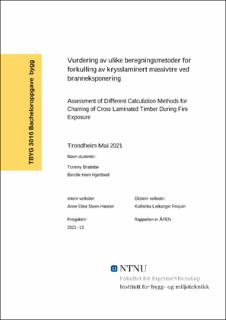| dc.contributor.advisor | Steen-Hansen, Anne Elise | |
| dc.contributor.advisor | Friquin, Kathinka Leikanger | |
| dc.contributor.author | Brattebø, Tommy | |
| dc.contributor.author | Hjartland, Bendik Horn | |
| dc.date.accessioned | 2021-09-20T16:27:52Z | |
| dc.date.available | 2021-09-20T16:27:52Z | |
| dc.date.issued | 2021 | |
| dc.identifier | no.ntnu:inspera:81154281:81155164 | |
| dc.identifier.uri | https://hdl.handle.net/11250/2779533 | |
| dc.description.abstract | Denne oppgaven omhandler vurdering av ulike standardiserte beregningsmetoder for forkullingsdybde og -hastighet av ubeskyttet krysslaminert massivtre. Krysslaminert massivtre også kalt KLT, har de siste årene opplevd økt popularitet som konstruksjonsmateriale, som et resultat av ny materialteknologi og klimapolitikk.
Utfordringene med tre materialer er at materialet defineres som brennbart, noe som betyr at branntekniske egenskaper i større grad må dokumenteres. NS-EN 1995 1-2: 2004 har så langt ikke inneholdt en tilstrekkelig standardisert metode for å beregne forkullingsdybde i KLT. Standarden er nå under revisjon og separate metoder vil bli implementert for å beregne forkulling i ulike massivtre-elementer. Hovedformålet med denne rapporten er å sammenligne standardiserte beregningsmetoder for forkulling i ubeskyttet KLT, med forkullingsdybder fra en fullskala branntest der ubeskyttet KLT har blitt brukt som bærende bygningsdeler. Beregningene i oppgaven er basert på europeisk, amerikansk og kanadisk standard for branndimensjonering av trekonstruksjoner.
Branntesten som ble brukt som sammenligningsgrunnlag er en fullskala branntest gjort av en studentboenhet fra prosjektet Moholt 50|50, lokalisert i Trondheim. Hensikten med disse sammenligningene er å se om de standardiserte beregningsmetodene vil gi en realistisk verdi for forkullingsdybde, sammenlignet med forkullingsdybden som oppstår under en reell brannsituasjon.
Rapporten inneholder en teoretisk del som er resultatet av en omfattende litteraturstudie som er utført i forbindelse med oppgaven. Branndimensjonering av trematerialer er et fagområde som består av mange variabler som må tas i betraktning, en bred forståelse av fagområdet er en suksessfaktor for å kunne gjøre gode vurderinger og konklusjoner.
Teorikapittelet i rapporten belyser relevant underliggende kunnskap i grunnleggende branndynamikk, brannstandarder, materialkunnskap, tidligere forskning og KLT sine opptredende egenskaper under brannbelastning. Basert på tilgjengelig teori og beregningene som er utført, er det konkludert med at ulike standardiserte beregningsmetoder for forkulling av ubeskyttet KLT, gir forskjellige og usikre resultater. I de aller fleste tilfeller gir beregningene lavere forkullingsdybde sammenlignet med forkullingsdybden gitt av branntesten. Oppgaven peker også på potensielle forbedringer som kan gjøres for å oppnå mer realistiske resultater ved beregning. | |
| dc.description.abstract | This thesis deals with an assessments of various standardised calculation methods for charring of unprotected cross laminated timber.
Cross laminated timber also called CLT, has in recent years increased its popularity in the construction industry as a result of material technology and climate policy. The challenges with wood based materials used in construction, are that the material is defined as combustible, which means that fire safety must be documented to a greater extent. European Standard NS-EN 1995 1-2: 2004 has so far not contained a sufficiently standardized method for calculating charring depth in CLT. The standard is now being revised, where separate methods will be implemented for calculating charring in various solid wood elements.
The main purpose of this report is to compare standardized calculation methods for charring in unprotected CLT, with charring depths from a fire test where unprotected CLT has been used. The calculations in the thesis are based on European, American and Canadian standards for fire dimensioning of wooden structures. The fire test used as a basis for comparison, is a fire test of a student dormitory from the project Moholt 50 | 50, located in Trondheim. The purpose of these comparisons is to see if the standardized calculation methods will provide a realistic value for the charring depth, compared to the charring depth that occurs under a real fire situation. The report contains a theoretical part that is the result of a literature study, that has been carried out in connection with the thesis. Fire dimensioning of wood materials is a subject area consisting of many variables that must be taken into account, a broad understanding of subject areas is a success factor in order to be able to make good assessments and conclusions.
The theory chapter of the report sheds light on relevant underlying knowledge in basic fire dynamics, fire standards, material knowledge, previous research and CLT properties under fire load. Based on available theory and the calculations that have been carried out, it has been concluded that various standardized calculation methods for charring unprotected CLT, give different and uncertain results. In the vast majority of cases, calculations give lower charring depth compared to the charring depths given by the fire test of unprotected CLT. The thesis also points to improvements that can be made to achieve more realistic results when calculating. | |
| dc.language | nob | |
| dc.publisher | NTNU | |
| dc.title | Vurdering av ulike beregningsmetoder for forkulling av krysslaminert massivtre ved branneksponering | |
| dc.type | Bachelor thesis | |
